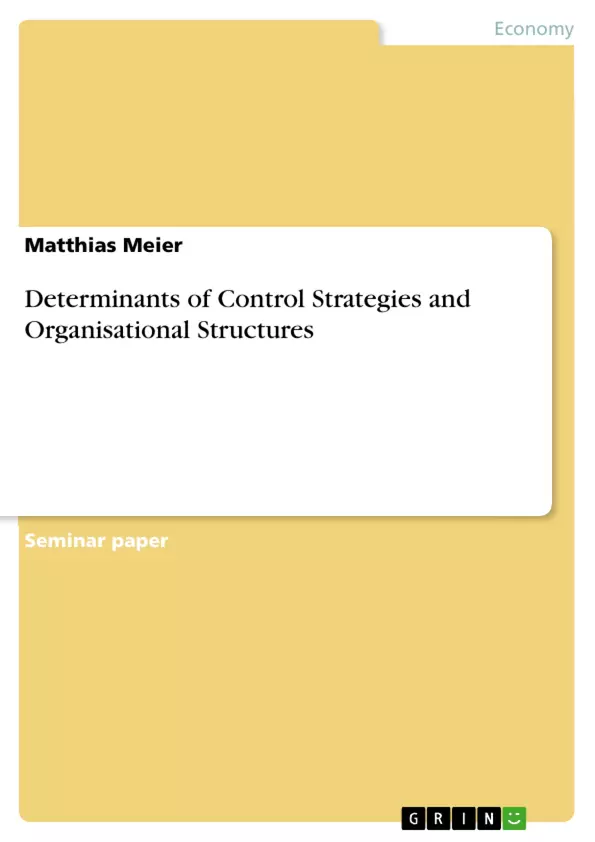From 1980 to 2002 Foreign Direct Investments (FDI) have grown by 12% per year (Unctad, 2004, p. 33). This indicates that Multinational Enterprises (MNEs) increasingly operate abroad through fully owned subsidiaries which have to be managed, controlled and coordinated by domestic headquarters. Therefore, it becomes more and more important for MNEs to choose an adequate control strategy combined with the most suitable organisational structure.
Due to a changing global environment, some of our competitors seem to change their organisational strategies and structures in order to achieve a competitive advantage. This report presents an overview of the determinants of strategies and structures adopted by MNE’s, the location of decision making and the types of mechanisms used to control foreign subsidiaries. The second chapter of this paper deals with the organisational environment and describes tools which can be used to assess the internal and external environment. The third chapter examines four control strategies. Organisational structures and control mechanisms are described in Chapter four. The fifth chapter examines the strategies and structures of our main competitors Procter & Gamble and Johnson & Johnson.
Table of Contents
- Introduction
- Organisational Environment
- Internal Environment
- External Environment
- PEST Analysis
- Porter's Five Forces
- Control Strategies
- International Strategy
- Global Strategy
- Multidomestic Strategy
- Transnational Strategy
- Organisational Structures and Control Mechanisms
- Organisational Structures
- International Division Structure
- Global Functional Division Structure
- Global Product Division Structure
- Global Area Structure
- Global Matrix Structure
- Control Mechanisms
- Organisational Structures
- Synthesis
- Cases
- Procter & Gamble
- Strategy
- Structure
- Johnson & Johnson
- Strategy
- Structure
- Procter & Gamble
Objectives and Key Themes
The primary objective of this report is to analyze the factors influencing the selection of control strategies and organizational structures by multinational enterprises (MNEs). The paper aims to provide a comprehensive overview of the determinants of these strategic decisions, focusing on the location of decision-making and the mechanisms used to control foreign subsidiaries.
- Internal and external environmental analysis as critical determinants of strategy and structure
- Different control strategies employed by MNEs to manage their international operations
- A detailed examination of various organizational structures and their associated control mechanisms
- Case studies analyzing the strategies and structures adopted by major companies like Procter & Gamble and Johnson & Johnson
- Synthesis and critical assessment of the interrelationship between control strategies, organizational structures, and environmental factors
Chapter Summaries
The report begins with an introduction highlighting the significant increase in foreign direct investments (FDI) and the growing importance of effective control strategies and organizational structures for MNEs operating globally. Chapter two delves into the organizational environment, focusing on the internal and external factors that influence strategic decisions. This includes tools like SWOT analysis for internal assessment and PEST analysis and Porter's five forces for external analysis.
Chapter three examines four distinct control strategies, encompassing international, global, multidomestic, and transnational strategies. These strategies are characterized by varying degrees of centralization and decentralization, with different implications for decision-making and control.
Chapter four focuses on organizational structures and control mechanisms. It discusses five key structures, including international division, global functional division, global product division, global area structure, and global matrix structure. The chapter also explores the various control mechanisms utilized by MNEs to effectively manage their international operations.
Chapter five delves into case studies of Procter & Gamble and Johnson & Johnson, providing insights into the strategic choices and organizational structures adopted by these leading companies. The analysis examines how these organizations leverage their strengths and adapt to the global environment.
Keywords
This report primarily focuses on key concepts such as control strategies, organizational structures, multinational enterprises (MNEs), foreign direct investments (FDI), strategic decision-making, environmental analysis (SWOT, PEST, Porter's Five Forces), organizational structures (international division, global functional division, global product division, global area structure, global matrix structure), and control mechanisms. Case studies of Procter & Gamble and Johnson & Johnson provide practical examples of how these concepts are applied in real-world scenarios.
- Quote paper
- Matthias Meier (Author), 2006, Determinants of Control Strategies and Organisational Structures, Munich, GRIN Verlag, https://www.grin.com/document/52011



